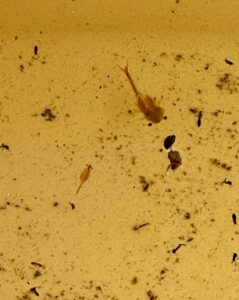By Jessica Johnsrud, education coordinator/assistant director
 Recently, some of the staff and DNR employees were conducting surveys in the swales within the preserve. It was a cool, March day and the wood frogs were singing all around us. A few people were slowly wading in a swale, looking for amphibians and their eggs. One staff member noticed something moving slowly through the water and carefully used a net to scoop it up. We put the creature in a small container with water for observation and realized we found fairy shrimp!
Recently, some of the staff and DNR employees were conducting surveys in the swales within the preserve. It was a cool, March day and the wood frogs were singing all around us. A few people were slowly wading in a swale, looking for amphibians and their eggs. One staff member noticed something moving slowly through the water and carefully used a net to scoop it up. We put the creature in a small container with water for observation and realized we found fairy shrimp!
Fairy shrimp are a bit of an oddball. They belong to the crustacean group, but do not have a hard exoskeleton like their relatives the lobster or shrimp. Adults have 20 segments to their body and eyes that stick out on the side of their head. Their tail is transparent and if you look closely, you may notice the beating of their tube-like heart. Fairy shrimp are found in temporary spring ponds and swales and are a signal that spring has arrived.
These organisms are small, only about ½-1 inch long and move slowly through the water. They swim with their belly-side up and have several long, leg-like appendages that gracefully sway back and forth. The legs help with locomotion, breathing and directing tiny organisms like protozoans, bacteria, algae and detritus (dead stuff) to its mouth. Their diet, along with their age and the bacteria present in the water, affect the color of the fairy shrimp, which can range in color from whiteish to orange to blue to red to green.
Male fairy shrimp have noticeably large heads because they have claspers for holding the female during mating. Mating takes place in April and May and the males die shortly after. The female carries her eggs in a sac on the underside of her body and the eggs are released every 2-6 days during her 1-3 week lifespan. The eggs are technically cysts or fully-developed embryos, meaning they can hatch as soon as conditions such as temperature, light, and water levels are optimal.
The cysts are incredibly hardy and stay dormant through the dry summer and freezing winter. They can even remain viable for several decades! Once snow melt and rain returns, the cysts hatch into larvae, which continually grow and molt until they are adults. The cysts have adapted to the uncertainty of life in a spring pond and only a small portion hatch at a time. This ensures that a bank of fairy shrimp cysts remains for the future.
Fairy shrimp are an important food source for salamanders, frogs, and waterfowl and their presence indicates a healthy ecosystem. They are truly a unique part of the ephemeral ponds and swales of spring.
Photo by Nancy Nabak
